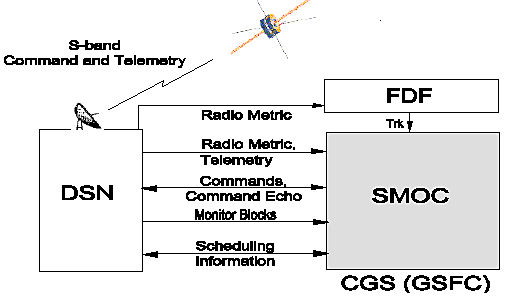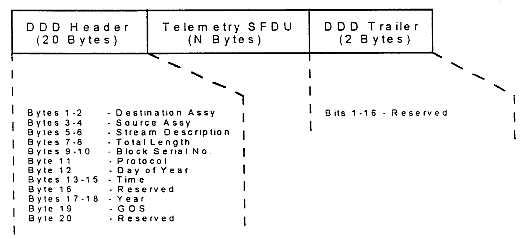

Figure 2000-1: IMAGE Spacecraft - Ground - SMOC Link
The DSN neither allocates nor commits its antenna resources. For the 26/34 meter subnet, these functions are performed by a committee of all Flight Project Users, the Joint User Resource Allocation Planning (JURAP) Committee, which generally is quite successful in negotiating antenna locations that are acceptable to all parties. Criteria relevant to these negotiations include science content, spacecraft navigation, spacecraft health and safety, and engineering data.
The IMAGE coverage requirements have been analyzed in terms of relative priority and daily intensity (i.e., hours/day) and in conjunction with other Flight Project Users of the DSN in 2000 - 2003. When the DSN estimates that there is a very high likelihood of being able to meet a particular coverage requirement, the response “accepted” is used. When the ability to meet a particular coverage requirement is less certain, the response "partially accepted" is used, and it is accompanied by further discussion of the DSN ability to meet that requirement.
The telemetry frame structure and Standard Format Data Unit (SFDU) used between DSN and GSFC are shown below in Figures 2000-2 and 2000-3. Refer to the IMAGE C&DH subsystem specification for the most current information.

Figure 2000-2: IMAGE Telemetry Data Block Physical Layout

Figure 2000-3: Telemetry SFDU Block Physical Layout
Table 2000-1: Telemetry Virtual Channel Layout
| VC | Rates | Data Content | PN Encoded VC |
| 0 | 44,000 bps | Real-time Housekeeping | 0x8 |
| 1 | 44,000 bps | Real-time Science | 0x9 |
| 2 | 2,285,700 bps | Playback Housekeeping | 0xa |
| 3 | 2,285,700 bps | Playback Science | 0xb |
| 4 | TBD | Memory Dump | 0xc |
| 63 | N/A | Fill | 0x37 |
The Physical Link Operation Procedure aboard the Observatory is compatible with a ground station operating in accordance with either CCSDS PLOP.

Figure 2000-4: Receiver Block Diagram
The IMAGE IDLE pattern is as follows: TBD
The IMAGE Command Link Transfer Unit (CLTU) structure is shown in Figure 2000-5?.

2200.1 The DSN shall accept ground station contact requests from
the SMOC.
DSN Response: Accepted
2200.2 The DSN shall provide the SMOC with a ground station
contact schedule.
DSN Response: Accepted
2200.3 The DSN shall notify the SCT of all schedule changes that
impact IMAGE.
DSN Response: Accepted
2200.4 The DSN shall provide 95% or greater reliability of
successful telemetry reception and recording, with a BER of 10-6 or better,
under strong (3db) signal conditions.
DSN Response: Accepted
2200.5 The DSN shall provide configuration status information,
beginning pre-pass, in the form of monitor blocks starting not later than 5
minutes after Beginning of Activity (BOA) in DSN Schedule at a minimum
frequency of one packet every five minutes. These monitor blocks shall be
in the format specified in DSN Monitor and Control System Interface with
Project Telecommunication Link Analysis, MON-5-15.
DSN Response: Accepted
2200.6 The DSN shall record all downlinked telemetry.
DSN Response: Accepted
2200.7 The DSN shall retain all recorded telemetry for 14 days.
DSN Response: Accepted
2200.8 The DSN shall initiate the delivery of real-time telemetry
(VC0 and VC1) to the SMOC with a latency of less than 10 seconds.
DSN Response: Accepted
2200.9 The DSN shall initiate delivery of playback telemetry via
FTP by virtual channel to the SMOC within LOS plus three hours.
DSN Response: Accepted
2200.10 The DSN shall deliver to the SMOC a Data Available Notice
containing the following information:
2200.10.1 File Name
2200.10.2 File Size
2200.10.3 File Location
2200.10.4 Machine name
DSN Response: Not Accepted
2200.11 The DSN shall time-tag at frame synch each frame to an accuracy of
0.01 seconds GMT.
DSN Response: Accepted
2200.12 The DSN shall provide the capability for command and radio metric
operations to occur simultaneously with telemetry reception during early
orbit and nominal operations; and provide in real-time during Launch, Early
Orbit, and Special Operations.
DSN Response: Accepted
2200.13 The DSN shall provide IMAGE Mission Support on the IP Multi-Mission Network
I/F between JPL and GSFC as specified by 820-13 module GCF 10-21.
DSN Response: Accepted
2200.14 The DSN shall uplink command data received from the SMOC within five
seconds of receipt during all passes scheduled for telemetry data
acquisition.
DSN Response: Accepted
2200.15 The DSN shall perform mission readiness testing and dataflows with SMOC
starting in Launch-14 months and continuing through Launch.
DSN Response: Accepted
2200.16 The DSN shall participate in simulations and spacecraft tests with GSFC,
LMMS, and VAFB elements starting in Launch-18 months and continuing through
Launch.
DSN Response: Accepted
2200.17 The DSN shall provide two-station coverage during critical IMAGE
operations. These operations include all supports in which the IMAGE
spacecraft will be performing maneuvers as well as all supports in which
the IMAGE spacecraft will undergo a major reconfiguration resulting from
non-nominal operations. Also included are launch, deployments, and the
first 12 hours after launch.
DSN Response: Accepted
2200.18 The DSN shall provide spacecraft emergency support as required.
DSN Response: Accepted
2200.19 The DSN shall provide 34 meter and 26 meter support for command, telemetry,
and radio metric data.
DSN Response: Accepted
2200.20 The DSN shall provide the capability to support a pass with an unmanned
SMOC.
DSN Response: Accepted (Details described in Appendix AA of the JPL to GSFC
ICD)
2200.21 The DSN shall record to hard media any data requested by the SMOC within 14
days.
DSN Response: Accepted
2200.22 The DSN CTT will be provided at LMMS and VAFB, for LMMS and launch site RF
Compatibility and E-T-E System Compatibility testing, with a NISN interface
to JPL.
DSN Response: Accepted
2200.23 The DSN shall provide a network interface to transmit VC0 and VC1 real-time
data to the SMOC.
DSN Response: Accepted
2200.24 The DSN shall support the receipt of CCSDS format commands from the SMOC
via a network interface.
DSN Response: Accepted
2200.25 The DSN shall provide coverage as per Table 2000-2.
Table 2000-2: DSN Coverage Requirements
| Mission Phase | Service | Passes/Orbit | Pass Durations |
|
Launch to L+7 days Reorientation |
DSN 34 m/ 26 m (S-band omni) |
Continuous | Continuous |
|
Spin-up #1 L+8 to L+14 |
DSN 34 m/ 26 m (S-band omni) |
1 | 1 - 30 min. pass per 13.5 hour orbit |
| Deploy #1 L+15 |
DSN 34 m/ 26 m (S-band omni) |
Continuous | Continuous |
| Spin-up #2 L+16 to L+18 |
DSN 34 m/ 26 m (S-band omni) |
1 | 1 - 30 min. pass per 13.5 hour orbit |
| Deploy #2 L+19 |
DSN 34 m/ 26 m (S-band omni) |
Continuous | Continuous |
| Spin-up #3 L+20 to L+22 |
DSN 34 m/ 26 m (S-band omni) |
1 | 1 - 30 min. pass per 13.5 hour orbit |
| Deploy #3 L+23 |
DSN 34 m/ 26 m (S-band omni) |
Continuous | Continuous |
| Science First Images L+24 |
DSN 34 m/ 26 m (S-band omni) |
1 | 1 - 30 min. pass per 13.5 hour orbit |
| Spin-up #4 L+25 to L+35 |
DSN 34 m/ 26 m (S-band omni) |
Continuous | Continuous |
| Instrument Checkout L+36 to L+39 |
DSN 34 m/ 26 m (S-band omni) |
1 | 1 - 30 min. pass per 13.5 hour orbit |
| Science HV(LENA) L+40 |
DSN 34 m/ 26 m (S-band omni) |
Continuous | Continuous |
| Nominal Ops L+41 to EOM |
DSN 34 m/ 26 m (S-band omni) |
1 | 1 - 30 min. pass per 13.5 hour orbit |
DSN Response: Accepted; The DSN estimates that IMAGE coverage requirements in table 2000-2 will be supported between 95% and 100%.
Author and Curator:
Dr. D.R. Williams, dwilliam@nssdc.gsfc.nasa.gov, +1-301-286-1258